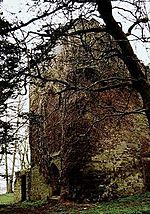Kilmahew Castle facts for kids
Quick facts for kids Kilmahew Castle |
|
|---|---|
| Cardross, Argyll and Bute, Scotland |
|

Kilmahew Castle
|
|
| Coordinates | 55°58′21″N 4°38′34″W / 55.97250°N 4.64278°W |
| Type | Rectangular tower house |
| Site information | |
| Owner | Catholic Church |
| Controlled by | Clan Napier until 1820 Various owners 1820 to present |
| Open to the public |
Yes |
| Condition | Ruin |
| Site history | |
| Built | Unknown, but after 1290 |
| Built by | Unknown member of the Clan Napier |
| In use | 15th century to 21st century |
| Materials | Stone |
Kilmahew Castle is an old, ruined castle located near Cardross in Argyll and Bute, Scotland. A ruined castle means it is no longer complete but still has parts standing.
The castle is close to the remains of St. Peter's Seminary. You can also find Kilmahew Burn, a small stream, nearby. Kilmahew is named after its patron saint, Mochta (also known as Mahew).
Contents
History of Kilmahew Castle
Kilmahew Castle stands on land given to the Napier family around 1290. This gift came from Malcolm, the Earl of Lennox. The Napier family built the castle sometime in the 1500s.
They owned it for a very long time, through 18 generations of their family. Many famous engineers came from the Napier family who lived at Kilmahew. For example, Robert Napier was known as the "Father of Clyde Shipbuilding." Other Napiers, like David, James, and Montague, started the engineering company Napier & Son.
Changes in Castle Ownership
In 1694, George Maxwell inherited the estate. He took on the Napier name from his grandfather. However, he did not have any children to pass the estate to.
After George Maxwell died, his daughter, Jean Smith, took over the estate. She later married David Brydie. In 1820, the castle was sold to Alexander Sharp. Then, in 1839, James Burns bought the estate. He was a shipowner and lived in the castle until he died in 1871.
The Archdiocese of Glasgow bought the castle ruins and the land around them in 1948.
Castle Design and Changes
Kilmahew Castle was first built as a four-storey tower house in the 1500s. A tower house is a strong, tall building used for living and defense.
Architectural Modifications
In 1744, some changes were made to the castle. These updates are thought to have been done by the architect John Douglas. Later, in the 1800s, more changes were made.
The owner at that time, Alexander Sharp, added Gothic style features. Gothic architecture often includes pointed arches and decorative details.

